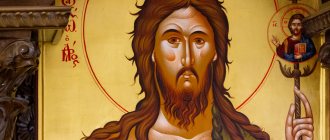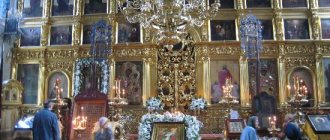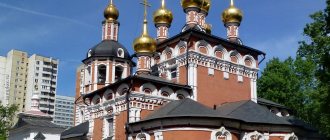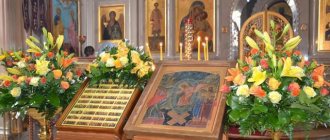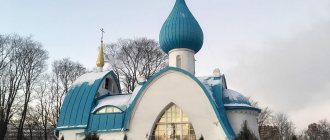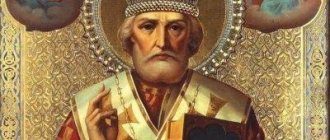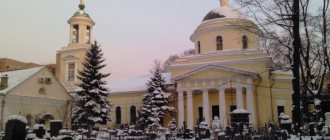"Save me, God!".
Thank you for visiting our website, before you start studying the information, please subscribe to our Orthodox community on Instagram, Lord, Save and Preserve † - https://www.instagram.com/spasi.gospodi/. The community has more than 60,000 subscribers. There are many of us like-minded people and we are growing quickly, we post prayers, sayings of saints, prayer requests, and timely post useful information about holidays and Orthodox events... Subscribe. Guardian Angel to you!
At various times, Orthodoxy suffered due to persecution by ruling officials. It was also difficult to preserve the buildings of temples and monasteries during times of revolutions and wars. But it happened that the “powers of this world” could simply by their decrees prohibit or allow this or that action. Thus, the Church of John the Baptist on Presnya is known not only for its beauty, but also for the fact that the start of its construction was delayed due to the decree of Peter 1 that it was forbidden to build stone churches all around, except in St. Petersburg.
History of appearance
The first memories of the wooden Church of the Nativity of John the Baptist on Presnya date back to 1685. Also, the icon of the “Nativity of St. John the Baptist” does not contradict this date. Although it is dated 1986, it must be remembered that then the calendar year began on September 1. But data on the appearance of this face was not preserved either in the Census Book or in other documents. The exit from this temple faces the street that leads to Vagankovo. But it should not be confused with a modern cemetery. In that context, we mean St. Nicholas Church.
The best article for you, go to: Church of St. Nicholas at the Straw Gatehouse
After the appearance of this monastery on Presnya, the number of courtyards began to grow. The parish grew, and with it the number of parishioners. Since the majority were not poor people, the question arose about the construction of a stone temple. In 1714, such a petition was submitted to the Tsar. Construction began but was suspended by decree.
Over time, in 1728, this order was canceled and construction continued. On December 7, 1731, a petition was submitted to consecrate the newly built temple. Around Christmas 1734, this procedure was completed.
In 1804, the wooden bell tower of the temple burned down. In its place, it was decided to build a stone three-tiered building. Its construction took from 1806 to 1810. Further, the entire 19th century became famous for the fact that construction constantly continued on the territory of the temple. The number of buildings grew, which made it possible to open new schools and other institutions.
In March 1922, they began to confiscate the Kremlin's church valuables. The documents say that the Church of John the Baptist also did not escape such a fate. But thanks to the actions of the abbot and the intercession of higher powers, he managed to avoid the renovationist schism.
The best article for you, go to: Life-Giving Spring Temple in Tsaritsyno, schedule of services
In 1930, the bells were removed from the temple, the entrance steps were damaged, and the graves of the cemetery were desecrated. In the post-war period, it became possible to bring the temple into proper condition, which is what the parishioners did. Over time, it became one of the most revered places in Moscow.
In our time, the temple continues to work, expanding the scope of its activities.
Cathedral of John the Baptist. history of the holiday
John the Baptist was born into the family of the priest Zechariah and the righteous Elizabeth . Zechariah and Elizabeth, having lived to old age, had no children. But the Lord heard their prayers, and Archangel Gabriel announced the birth of his son to the priest Zechariah while he was in the temple. When King Herod, having learned from the Magi about the birth of Jesus Christ, ordered to kill all the babies in Bethlehem, the mother of John the Baptist, Elizabeth, managed to leave with her son into the desert. His father, Zechariah, served in the Temple of Jerusalem these days. When they came to him with a demand to hand over his son, the priest replied: “I now serve the Lord God of Israel, but where my son is now, I don’t know.” Angry soldiers killed him right near the altar. Nothing is known about the childhood and youth of John the Baptist. John grew up in the wild and ethereal desert, preparing himself for prophetic service through strict fasting, contemplation of God and prayer. At the age of about 30, John went out preaching to the banks of the Jordan River, thereby preparing the people to accept the Savior of the world. Many, imbued with the words of the great preacher, were baptized in the waters of the Jordan. The Lord Jesus Christ himself came to the Jordan to receive baptism from John.
Baptism of the Lord, icon, 16th century
After the Baptism of the Savior, John continued his preaching, calling people to repentance, denouncing sins and vices. John the Baptist ended his earthly life as a martyr. He denounced King Herod Antipas (20 BC - after 39 AD) for leaving his lawful wife and cohabiting with Herodias, the wife of his brother Philip. John was captured and imprisoned. During the celebration of his birthday, Herod held a feast, to which many nobles, a thousand chiefs and elders were invited. Salome, the daughter of Herodias, appeared at the feast, who pleased the king with her dancing, and he ordered her to ask him for everything she wanted. She consulted with her mother, who, having decided to take revenge on John for his accusations, told her daughter to ask Herod for the head of John the Baptist. Herod was saddened; he feared the wrath of God for the murder of the Prophet, whom he himself had previously obeyed; he also feared the people who loved the holy Forerunner. However, because of the guests and the lawless oath, he sent a soldier to prison to cut off the head of John the Baptist and give it to Salome. The God-fearing and pious Joanna, the wife of Herod’s steward, Khuza, secretly took the holy head of John the Baptist and buried it in an earthen vessel on the Mount of Olives. That same night, the disciples of the Forerunner took the holy body and buried it in Sebastia, where the murder was committed. When rumors reached the royal palace about the preaching of Jesus Christ and the miracles He performed, Herod and his wife Herodias went to check whether the head of John the Baptist was in place. Not finding her, they began to think that Jesus Christ is the resurrected John the Baptist, as evidenced by the Gospel (Matthew 14:2; Luke 9:9-7). The relics of John the Baptist (except for the head and right hand) were burned along with the Sebastian Temple by order of Emperor Julian the Apostate in 362.
Temple shrines
There are several revered shrines on the territory:
- icon of St. Nicholas the Pleasant in his life,
- icon “Angel of the Desert”,
- icon of Saint John the Warrior,
- icon “Our Lady of Akathista”,
- icon “Our Lady of Shuya”,
- icon "Nativity of John the Baptist",
- Icon “Thy Womb Was the Holy Meal.”
Cathedral of John the Baptist. Holiday event
In the Orthodox Church, the custom has been established on the next day of the great feasts of the Lord and the Mother of God to honor the memory of those saints who served this sacred event in history. Thus, the day after Epiphany, the Church honors the holy prophet John the Baptist , who served the Baptism of Christ by laying his hand on the head of the Savior. The word “cathedral” means a meeting of people who give honor and praise to the holy prophet and Forerunner, John the Baptist of the Lord. John the Baptist is a great prophet who completes the history of the Old Testament Church and opens the era of the New Testament. “We celebrate the Council of the Honest Forerunner above tradition, as I served the mystery of divine baptism” (Great Menaion of Chetia, collected by All-Russian Metropolitan Macarius). The Holy Prophet John testified to the coming to earth of the Only Begotten Son of God, who took on human flesh. John the Baptist was honored to baptize Him in the waters of the Jordan and testified to the mysterious Appearance of the Most Holy Trinity on the day of the Baptism of the Savior.
Library of the Russian Faith Cathedral of St. John the Baptist. Great Menaion of Cheti →
Read online in original
Schedule of services
It is necessary to remember that the schedule of services of the church on Presnya may change and it is advisable to clarify such information either by phone or on the monastery website.
The main services are conducted as follows:
- daily Liturgy at 7.30, on holidays at 9, Vespers and Matins at 18 (in winter at 17.00);
- on Sundays and great holidays two Liturgies are held at 07 and 10 am;
- The night before, an all-night vigil is held at 6:00 p.m., and in winter at 5:00 p.m.
The best article for you, go to: Church of the Resurrection of the Word in Bryusov Lane
Nativity of John the Baptist on Presnya, temple
Central Deanery
September 13, 2018
Parish of the Church of the Nativity of John the Baptist on Presnya.
Address: 123242, Moscow, M. Predtechensky lane, 2 El. mail: Temple website: www.ioannpr.ru Phone/fax:
HISTORICAL REFERENCE
The parish of the Church of the Nativity of John the Baptist on Presnya was founded in 1685, with the blessing of His Holiness Patriarch Joachim of Moscow and All Rus'.
The modern building of the three-altar church was built in 1734. Architect unknown.
In 1806-1810 the bell tower was built.
In the 1890s, the workshop of the great Russian artist V. M. Vasnetsov worked in the temple. The paintings of the main temple were done by his hand.
The temple was the church-administrative center of Georgian parishes in Russia and had the status of a metochion of the Georgian Orthodox Church in Moscow.
The main altar is consecrated in honor of the Nativity of John the Baptist, the side chapels are in honor of the martyr John the Warrior and in the name of Sophia, the Wisdom of God.
The temple is one of the few in Moscow that was not closed under Soviet rule.
On July 7, 2010, on the feast of the Nativity of the venerable, glorious Prophet, Forerunner and Baptist of the Lord John, His Holiness Patriarch Kirill of Moscow and All Rus' performed the rite of great consecration of the temple in connection with the fundamental restoration of the building and interior of the temple, as well as the reconstruction of the central altar.
SACRED TEMPLE
Ark with the relics of St. John the Baptist (three particles from Mount Athos). Cross with the relics of many saints of the Universal Church. Icons of St. Seraphim of Sarov, Martyr Tatiana and St. Mitrophan of Voronezh with the relics of these holy saints of God.
WORSHIP
On Saturdays and Sundays, as well as on the days of the twelve and great holidays - The early Divine Liturgy begins at 7.00, late at 9:30 on the eve of the All-Night Vigil at 17.00. On Monday at 17.00 akathist to St. John the Baptist (except for the days of Great Lent and the after-feast of the Twelve Feasts).
CLERGY
Metropolitan of Korsun and Western Europe ANTONY (Sevryuk Anton Yuryevich), rector. Born October 12, 1984. Education: St. Petersburg Theological Seminary and Academy On March 5, 2009, he was tonsured a monk. March 7, 2009 ordained as hierodeacon. On April 3, 2010 he was ordained hieromonk. On October 23, 2015, he was elevated to the rank of Bishop of Bogorodsk. On October 28, 2015 he was appointed rector of the temple.
Archpriest Valery Dmitrievich MISHIN, supernumerary cleric. Education: Moscow State University. Lomonosov. On June 4, 1993, he was ordained a deacon. May 22, 1998 – promoted to presbyter. On April 9, 2019, he was assigned to the staff.
Priest Dionisy Vasilievich LOBOV. Born March 11, 1976. Education: Orthodox St. Tikhon's Theological Institute, candidate of theology. On April 16, 2000, he was ordained to the rank of deacon. In 2002 - promoted to presbyter.
Priest Alexey Valerievich VORONTSOV. Born April 6, 1981. Education: secondary. On March 28, 2010, he was ordained to the rank of deacon. January 19, 2012 - to the rank of presbyter.
Priest Maxim BOYAROV. Born March 18, 1990. Education: Moscow Theological Seminary and Academy. September 29, 2013 ordained to the rank of deacon. On March 16, 2014 he was ordained to the rank of priest. April 17, 2021 sent to temporary service at the Church of the Nativity of John the Baptist on Presnya.
Deacon Kirill Alexandrovich ZHURAVLEV.
Deacon Evgeny Vladimirovich KUZNETSOV. Born December 12, 1983 Education: Tobolsk Theological Seminary, Moscow Theological Academy January 1, 2010 ordained to the rank of deacon August 27, 2021 sent to temporary service in the Church of the Nativity of John the Baptist on Presnya.
Deacon Sergei Pavlovich BOBROV. Born May 1, 1974. Education: Moscow Institute of Economics and Law. Ekaterinburg Theological Seminary.
DRIVING DIRECTIONS
Troparion and Kontakion for the Feast of the Cathedral of John the Baptist
Troparion, p®techi, voice, v7.
Remembrance of the righteous with 8 praises, you are satisfied with the testimony of more than anything else, kwi1l bo sz є3si2 truly the most honest prophet, ћko and 3 in 8 bhstrinakh krti1ti spod0bilsz є3si2 preached. at the same time, having truly suffered. He preached the gospel of the world, and of the world that gives us great mercy.
Code, voice, *7. self-voice.=
Pl0tskagw thi2 will come, with0 fear of return. The prophetic ministry is completed by the awe of the Holy Spirit. ѓgGlstіi chi1ni divlskhusz, zrsshe tz in the waters of flesh kRschaema. and3 all2 that exist in this enlightenment, praising tS ћvlshagosz, and3 enlightenment of everything.

